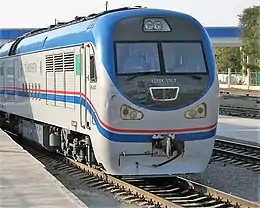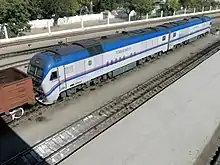Türkmendemirýollary
Türkmendemirýollary Agency (Turkmen Railways) is a state-owned operator of railways in Turkmenistan. The company operates 4,980 km (3,090 mi) of railways (37th in the world) and over 345 railway stations throughout the country. The company belongs to the Ministry of Industry and Construction Operation of Turkmenistan.[3] It is headquartered in Ashgabat.
 Turkmen Railways' diesel locomotive CKD9A of Chinese origin | |
| Overview | |
|---|---|
| Headquarters | Turkmenbashi str., Ashgabat |
| Locale | Turkmenistan |
| Technical | |
| Track gauge | 1,520 mm (4 ft 11 27⁄32 in) |
| Length | 4,980 km (3,090 mi) |
 | |
Native name | «Türkmendemirýollary» agentligi |
|---|---|
| Type | Government owned |
| Industry | Railways |
| Predecessor | Ministry of Industry and Construction Operation of Turkmenistan[1] |
| Headquarters | Ashgabat , Turkmenistan |
Area served | Turkmenistan |
| Services | Rail transport, Cargo |
| |
| Owner | Turkmen Government |
Number of employees | 5000 (2020)[2] |
| Website | www |
History
Russian Empire
In September 1880, the first section of the railway was built from the eastern coast of the Caspian Sea to the Mollagara. In October 1881, the railway was built to the village of Kyzyl-Arvat. In the years 1885-1886 was continued the construction of the second section of the railway to the large settlements of Turkmenistan: Geok-Tepe, Ashgabat, Tejen, Mary, Chardzhou, which ended at the Amu Darya river.
At the end of 1887, a wooden bridge with a length of more than 2 km was built across the Amu Darya, which allowed the construction of the third section of the road to begin. In 1901, a wooden bridge was destroyed by flood waters. In its place, at the same time, a new metal bridge was built on stone supports. In 1888, the railway continued to Samarkand and in 1898 brought to Tashkent. In 1894-1895, the Krasnovodsk section of the railroad was built. Thus, the Trans-Caspian Railway, which played an important role in the development of the economy of Central Asia, including pre-revolutionary Turkmenistan, begins from the harbor of the Caspian Sea - the Krasnovodsk Bay. The route from Krasnovodsk to Tashkent was called the Central Asian Railway.
Soviet Union
In 1922, on the instructions of Vladimir Lenin, work began on the design of Soviet diesel locomotives for operation on waterless sections of Central Asia. In 1931, the Krasnovodsk-Chardzhou railway was switched to diesel traction. In 1955, all railway traffic in the Turkmen SSR was completely transferred to diesel traction.
A very important role was played by rail during the Second World War. During the battles near Stalingrad and the Caucasus (from August 1942 to February 1943), the Krasnovodsk port and Ashgabat railway station became the only transport arteries connecting Baku, Transcaucasia and the Black Sea with the whole country. They ensured the transfer of the army, a huge flow of military equipment and equipment to the North Caucasian and Transcaucasian fronts. For the selfless work of the railway of the Turkmen SSR, the passing Red Banner of the People's Commissariat of Railways of the USSR was repeatedly awarded.
In the post-war period, the improvement of the technical equipment of the railway network of Turkmen SSR, its carrying capacity and capacity continued. At almost all stations and crossings, comfortable passenger buildings, platforms and canopies were equipped. Air conditioning wagons were also commissioned, creating favorable microclimatic conditions for passengers. Turkmen railways became one of the first in the USSR, on which the main diesel traction was introduced. In the early 1980s, the Mary-Kushka line was brought to the Afghan village of Torghundi.
Independent Turkmenistan

The Türkmendemirýollary formed after the dissolution of the Soviet Union, is one of the inheritors of the Soviet Railways. The railway's most important station is Ashgabat railway station, the central station of the capital. After the collapse of the USSR, the construction of new lines again intensified, which was caused by the fact that the previous routes were broken by sections that became part of the Uzbek railways. During the period after the collapse of the USSR, a number of new trunk lines were opened in Turkmenistan: Takhiatash (Uzbekistan)-Kunya-Urgench-Saparmurat Turkmenbashi, Turkmenabad-Atamyrat-Kerkiçi, Tejen-Sarakhs (Iran), Ashgabat-Daşoguz, which made it possible to connect disparate sections of the railway network into a single whole.
In October 2013, the new building of the Ministry of Railway Transport of Turkmenistan was opened on Archabil Avenue.[4]
Since February 7, 2020 Türkmendemirýollary Agency is in the department of new Ministry of Industry and Construction Operations of Turkmenistan.[5]
Activities
The main activities of Turkmen Railways involve freight and passenger traffic. Agency annually serves approximately 6 million passengers. The passenger department employs 5,000 specialists.[6]
Rolling stock
The locomotive fleet consists of diesel locomotives of the 2TE10L, 2TE10U, 2M62U series, there are also several locomotives of Chinese production CKD9A and Kazakh production TE33A.[7] Shunting work is performed by diesel locomotives TEM2, TEM2U, ChME3.
Railways projects
Links to Iran
In 1996, Mashhad–Sarakhs extension connected Iran to Turkmenistan,as part of the Silk Road railway to link to the landlocked Central Asian Countries.Former states of the Soviet Union have railways using a 1,520 mm (4 ft 11 27⁄32 in) Russian gauge,thus the Iranian Railways maintain break-of-gauge services at borders to Azerbaijan and Turkmenistan,and beyond brief wide-track rail segments to the border crossing.
Kazakhstan-Turkmenistan-Iran railway (part of the North-South Transport Corridor)
Türkmendemirýollary is engaging on a major railroad project to link China and Southeast Asia to Europe for a length of 3,900 kilometres (2,400 mi). Currently is run the railway through Turkmenistan to Iran. Iran is linked to Turkey and Europe's standard gauge system. In May 2013, a new rail link opened between Uzen (Kazakhstan) and Serhetyaka (Turkmenistan), crossing the border at Bolashak. The railway is 146 km long and cost 65bn tenge. The railway is Russian gauge; there would be a break of gauge when the railway reaches the Iranian border. In December 2014,a rail line from Iran opened to Turkmenistan and Kazakhstan. The opening of the line marks the first direct rail link between Iran,Kazakhstan and China and upon completion of the Marmaray rail project direct rail transport between China and Europe(while avoiding Russia)will be possible.[8][9]
Afghanistan–Turkmenistan rail service
A 10-kilometer long line extends from Serhetabat in Turkmenistan to the town of Torghundi in Afghanistan.[10] An upgrade of this Soviet-built line dating back to the 1960s, using Russian gauge, began in 2007.[11] In April 2016, an agreement was reached for a technical feasibility study for a proposal to extend this line approximately 100 km to the city of Herat,[12] where it could connect to the standard-gauge line to Iran that is being built. In accordance with earlier decisions, the line is likely to be standard gauge, with break of gauge at Torghundi. In April 2018 it was decided by the Turkmen government to build a railway from Galkynysh Gas Field in the direction of Afghanistan, towards Torghundi.[13][14]
Another rail line was opened further east in November 2016, connecting Aqina in Faryab province via Imamnazar with Atamyrat/Kerki in Turkmenistan.[15] A planned 58 kilometres (36 mi) extension to Andkhoy is under proposal.[16] It is planned to become part of a rail corridor through northern Afghanistan, connecting it via Sheberghan to Mazar-i Sharif and on to the border with Tajikistan,[17] although it is unclear when this will happen.[18]
Railway links with adjacent countries
- Kazakhstan – same gauge (former Soviet Union railway system) – new rail link opened in 2013.
 Iran-open-break-of-gauge.1,520 mm (4 ft 11 27⁄32 in).
Iran-open-break-of-gauge.1,520 mm (4 ft 11 27⁄32 in).
See also
References
- New Ministry of Industry and Construction Operations of Turkmenistan
- О нас
- New Ministry of Industry and Construction Operations of Turkmenistan
- О нас
- "Archived copy". Archived from the original on 14 August 2019. Retrieved 4 December 2014.CS1 maint: archived copy as title (link)
- Kazakhstan-Turkmenistan-Iran Railway to Open Today, by Onur Uysal, http://railturkey.org/2014/12/03/kazakhstan-turkmenistan-iran-railway/ Archived 5 December 2014 at the Wayback Machine
- Kakar, Javed Hamim (December 2017). "Construction of Turkmen-Afghan railroad begins". Pajhwok Afghan News. Retrieved 1 December 2017.
- "Afghan rebuild underway". Railway Gazette International. 2007-07-12.
- "Herat railway feasibility study contract signed". Railway Gazette. 18 April 2016.
- https://www.azernews.az/region/141734.html
- http://orient.tm/en/2018/04/12/6314.html
- Salehai, Zarghona (28 November 2016). "Afghan-Turkmenistan railroad inaugurated". Pajhwok Afghan News. Retrieved 17 January 2017.
- Hejaab, Aslam (31 October 2016). "Work Begins On Aqina-Andkhoy Railway". ariananews.af. Retrieved 17 January 2017.
- Grantham, Andrew (31 October 2016). "TAT Railway". Railways of Afghanistan. Retrieved 19 January 2017.
- https://www.railwaygazette.com/news/news/asia/single-view/view/afghan-railway-terminal-expansion-mou-signed.html